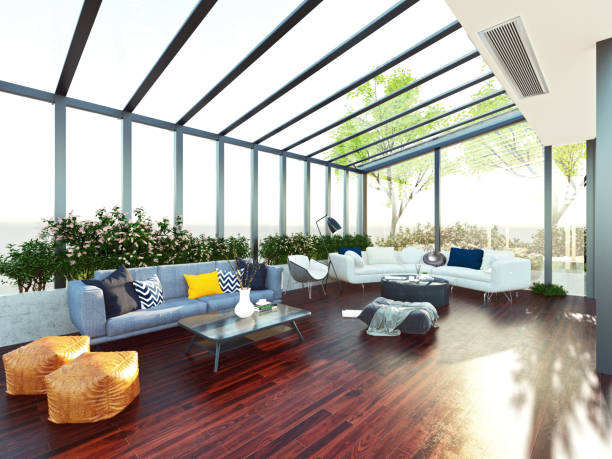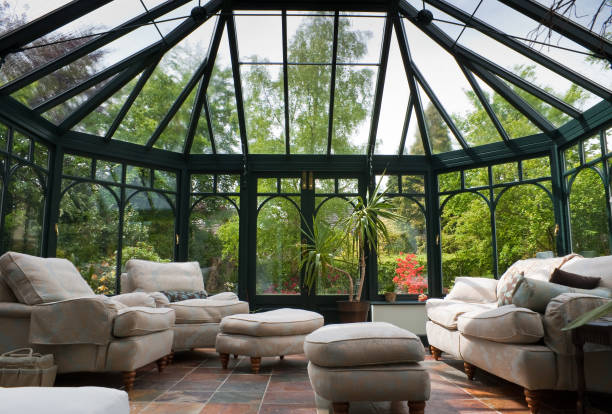Are you thinking about building a conservatory on to your London home? Needing some extra space, or simply wanting to add a slice of classic British charm to your property?
Building a conservatory is no small undertaking. And to ensure that your project goes smoothly and turns out to be everything you hoped for, we’re going to share our tips on conservatory construction.
Conservatories continue to be one of London’s favorite home renovation projects. Why? Because they’re typically light, bright, and airy, and offer the perfect way to soften and blend that line between the inside and the outside of your home.
So,
What is a Conservatory, and What are Conservatories Used For?
In Britain, a conservatory is defined as a room that has a hefty portion of its side wall (and often part of the roof) clad with glass or some other form of translucent material. It is generally attached to the original house or building, often at the rear of the property.

The uses of a conservatory are many and varied! It can become an extra living space, a sun parlor, a playroom, a work-from-home corner, a hobby room, a gaming or TV zone, and/or a place to grow houseplants.
Kitchen conservatories are a new trend that is gaining popularity across London: with so much sunlight, your conservatory offers the perfect place to cook, entertain and relax with family and friends.
What are the Advantages of a Conservatory?
‘Why should I build a conservatory?’ we hear you ask. It’s a good question, and we believe you should know all the pros and cons before you dive into your project:
Reasons to Build Your Own Conservatory:
- Increased living space – extra living space is always a plus, especially if you have a growing family or are frequently entertaining guests. A conservatory can provide a stylish yet cosy area for your family and friends.
- Increased natural light – as we know, natural light is sometimes a scarce commodity in London, especially during the winter months when the days are shorter! Adding a conservatory is a great way to maximize the amount of natural light your home receives and make the most of every minute of sunshine.
- Increase the resale value of your property – if it’s done right, adding a conservatory may be a great way to boost the resale value of your home. This is especially important if you are renovating your home with a view to selling it in the future.
- Make the most of your garden – if you’re an avid gardener, your conservatory will allow you to enjoy views of your garden all year round!
- Improve the energy efficiency of your home – with so much natural light pouring into your home, you will be less dependent on artificial lighting. In addition to this, many modern conservatories are designed using energy-efficient glass and insulation, which can go a long way toward keeping your home warm during winter and cooler in summer.
How to Build Your Own Conservatory?
Combit Constructions are one of North London’s leading home renovation teams, and we understand everything that’s involved in building a conservatory. And we believe our clients should understand each and every stage of how to build a conservatory too.

That’s why we’ve broken the process down into #7 steps here:
1. Design
Step number one is to plan and design the structure. What do you want your conservatory to look like? You will need to decide on the size, style, and materials you wish to use in the construction, as well as its location on the property.
We recommend involving the professionals from the get-go: you may choose to consult an architect or conservatory specialist for advice and/or to draw up your design.
2. Planning Permission
Depending on the size, height, and position of your conservatory, you may require planning permission. In London, there are specific guidelines and regulations that govern the construction of conservatories, so it’s important to check with your local council before proceeding.
3. Choose a Building Team
This is one of the most important steps of your project. Take your time about choosing the team that are going to be responsible for the construction of your conservatory, because you’re relying on them to turn your dreams into a reality!
Do your research thoroughly, both online and by talking to others who have successfully completed projects similar to yours. Visit showrooms; look at reviews; ask for referrals.
4. Site Preparation
Once planning permission has been obtained, the site will need to be prepared for conservatory construction. This may involve removing any existing structures or landscaping, excavating the area, and leveling the ground. Utilities such as water and electricity will need to be installed.
5. Construction
This is where it gets exciting! Firstly, the frame and roof of your conservatory will be built, then windows and doors will be installed.
Materials used in the construction of a conservatory typically include aluminum or steel frames, glass or uPVC, timber, and brick. Windows and doors need to be sealed and insulated to prevent drafts and ensure energy efficiency. Roofs may be tiled, glazed, or constructed using polycarbonate.
Depending on the design of your conservatory, you may also install skylights, ventilation, and blinds.
6. Finishing Touches
Once the external structure is complete, it’s time to focus on the interior finishes. This may include flooring, wall coverings, and lighting. You may also want to add furnishings such as cabinetry, tables, lounge suites, and plants to create that comfortable and inviting space.
7. Obtain Building Regulation Approval
Before you can enjoy using your new conservatory, you’ll need to obtain building regulation approval from your local authority. This ensures that your conservatory complies with safety and quality standards and meets all necessary regulations.
Adding a conservatory to your property in London could be your ticket to boosting the value of your home and increasing its comfort and functionality. With careful planning and the help of experienced professionals, you can create a beautiful and functional conservatory that dramatically enhances your home and improves your quality of life.
FAQs
Is it cheaper to build a conservatory or an extension?
Unfortunately, there’s no one-size-fits-all answer to this question! The relevant costs for each project depend on the size of the room being constructed, the materials and labor involved, and the level of finish.
However, a conservatory is generally considered to be a cost-effective way of extending a property. For more specific information regarding the cost of your project, check out our Building Cost Calculator, which can give you an accurate estimate of the cost of your project.
Is it legal to build a conservatory?
Depending on the size, height, and position of your conservatory, you may require planning permission before you can begin your project.
What are the disadvantages of conservatories?
Every project has disadvantages as well as advantages, and here are some of the cons of building a conservatory:
- Temperature inconsistencies
- Lack of privacy if your conservatory has a lot of glass panels
Is it safe to sleep in a conservatory?
Your conservatory could be used as a sleeping quarter, provided it is well-ventilated and the temperature is consistent. However, if your conservatory is poorly sealed and damp, it may be prone to grow mould which is a serious health concern.

